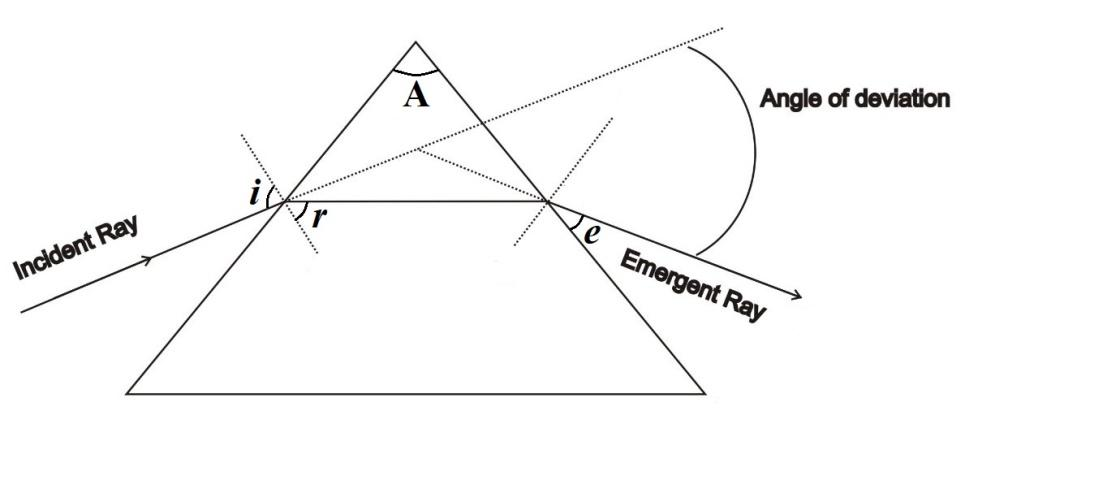
In an experiment to trace the path of a ray of light through a glass prism for different values of angle of incidence a student would find that the emergent ray:
A. is parallel to the incident ray
B. perpendicular to the incident ray
C. is parallel to the refracted ray
D. bends at an angle to the direction of incident ray
Answer
578.4k+ views
Hint: Refraction is the bending of light ray when it goes from one medium to another having different values of refractive indices. When a ray of light enters a glass prism it suffers deviation two times. For finding the direction of emergent ray, we have to consider that the refracting surfaces of the prism are not parallel to each other.
Complete step by step answer:
Refraction is the phenomenon of bending of a light ray when it goes from one medium to another having different values of refractive indices. A glass prism is a transparent glass object having two triangular ends and three rectangular sides. The refraction of light in a glass prism is different from that in a glass slab. This is because in glass prisms, the incident ray of light is not parallel to the emergent ray of light.
When a ray of light passes through a glass prism, refraction of light occurs both the times, when it enters the glass prism as well as when it leaves the glass prism. Since the two refracting surfaces are not parallel to each other, therefore, the emergent ray and incident ray are not parallel to one another.
The paths followed by the incident ray and the emergent ray on passing through a prism are at different angles. Upon refraction of a ray of light through prism, the emergent ray always bends at an angle with incident ray called angle of deviation.
When a ray of light enters the glass prism it suffers deviation two times. First when the ray enters the glass prism and second when it comes out of the glass prism. This is because the two refracting surfaces of the glass prism are not parallel to each other.

Upon refraction of a ray of light through prism, emergent ray bends at an angle to the direction of incident ray.
Hence, the correct option is D.
Note:
The refraction of light rays in a glass prism is different from that in a glass slab. In case of a class prism, the incident ray of light is not parallel to the emergent ray of light. When the ray of light passes through the glass prism it bends towards the base of the prism.
Complete step by step answer:
Refraction is the phenomenon of bending of a light ray when it goes from one medium to another having different values of refractive indices. A glass prism is a transparent glass object having two triangular ends and three rectangular sides. The refraction of light in a glass prism is different from that in a glass slab. This is because in glass prisms, the incident ray of light is not parallel to the emergent ray of light.
When a ray of light passes through a glass prism, refraction of light occurs both the times, when it enters the glass prism as well as when it leaves the glass prism. Since the two refracting surfaces are not parallel to each other, therefore, the emergent ray and incident ray are not parallel to one another.
The paths followed by the incident ray and the emergent ray on passing through a prism are at different angles. Upon refraction of a ray of light through prism, the emergent ray always bends at an angle with incident ray called angle of deviation.
When a ray of light enters the glass prism it suffers deviation two times. First when the ray enters the glass prism and second when it comes out of the glass prism. This is because the two refracting surfaces of the glass prism are not parallel to each other.

Upon refraction of a ray of light through prism, emergent ray bends at an angle to the direction of incident ray.
Hence, the correct option is D.
Note:
The refraction of light rays in a glass prism is different from that in a glass slab. In case of a class prism, the incident ray of light is not parallel to the emergent ray of light. When the ray of light passes through the glass prism it bends towards the base of the prism.
Recently Updated Pages
Master Class 12 Economics: Engaging Questions & Answers for Success

Master Class 12 Maths: Engaging Questions & Answers for Success

Master Class 12 Biology: Engaging Questions & Answers for Success

Master Class 12 Physics: Engaging Questions & Answers for Success

Basicity of sulphurous acid and sulphuric acid are

Master Class 12 Business Studies: Engaging Questions & Answers for Success

Trending doubts
What are the major means of transport Explain each class 12 social science CBSE

Which are the Top 10 Largest Countries of the World?

Draw a labelled sketch of the human eye class 12 physics CBSE

How much time does it take to bleed after eating p class 12 biology CBSE

Explain sex determination in humans with line diag class 12 biology CBSE

Differentiate between homogeneous and heterogeneous class 12 chemistry CBSE




